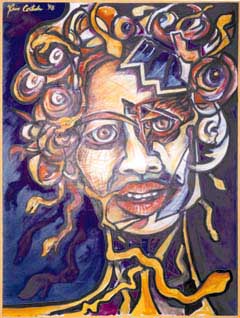City Link Gallery
December 15, 1999
 Medusa, acrylic on canvas, 48″ X 36″
Medusa, acrylic on canvas, 48″ X 36″
By Candice Russell
Xavier Cortada
The fact that his father and uncle were artists explains why Xavier Cortada, 35, became one, too. But his impressive résumé as a lawyer and social activist who uses art for change is purely his own idea.
Cortada’s figurative yet abstract paintings represent “an amalgamation of different influences,” he says. “Obviously, they draw on expressionism and cubism. But I’ve also been nurtured by Saturday morning cartoons and the stained glass windows in Catholic churches.”
There were detours along the way. As an honors pre-med student, he worked in hospitals only to discover this wasn’t his calling. He got a master’s degree in public administration, then switched again to become a lawyer with a special interest in criminal justice and juvenile delinquency.
What turned the tide was a meeting with homeless children in Soweto, South Africa, where Cortada went with the U.S. Information Agency. “They were listening to me through a translator and there was no spark there,” he says.
“When I returned with a sketch I’d done of one kid, it made them connect. Then they started drawing.
“In trying to find my path, I got on this journey,” says the artist.
This Friday at 12:15 p.m., Cortada’s latest project of a glass mosaic mural will be unveiled at Juvenile Courts, 3300 N.W. 27th Way in Miami. Measuring 16-feet-high and 24-feet-long, it portrays a child jumping out from strangely organic-looking sheets of paper with blood vessels and other human parts.
15gal2.JPG (31067 bytes)”Every arrest report, every form filed by a social worker is life-forming for these kids,” explains Cortada of the mural’s meaning. “I did it as a Rorschach test with all sorts of symbolism about the totality of the juvenile’s experience within the justice system.”
The artist, who counts Picasso and Francis Bacon as strong influences, also is proud of the contributions he sought from troubled kids at the facility. They made drawings about their own experiences that will be on display. “They are in the system because they have hurt people they don’t know,” says Cortada. “Here’s a chance for them to help someone else just because.”
 South Florida is “my life,” he says. “More than a Cuban-American artist or a social artist, I’m a Miami artist. I’ve traveled all over the world, but it’s the only place I call home. From the McDuffie riots to the Mariel boatlift, the climate, the people, Miami has nurtured me in every way. All the local politics have taught me what it means to be a Cuban.
South Florida is “my life,” he says. “More than a Cuban-American artist or a social artist, I’m a Miami artist. I’ve traveled all over the world, but it’s the only place I call home. From the McDuffie riots to the Mariel boatlift, the climate, the people, Miami has nurtured me in every way. All the local politics have taught me what it means to be a Cuban.
“When I think of Miami, I don’t think of the light. I think of the totality of what it means. It’s raw and on the edge, a Renaissance city in the making.”